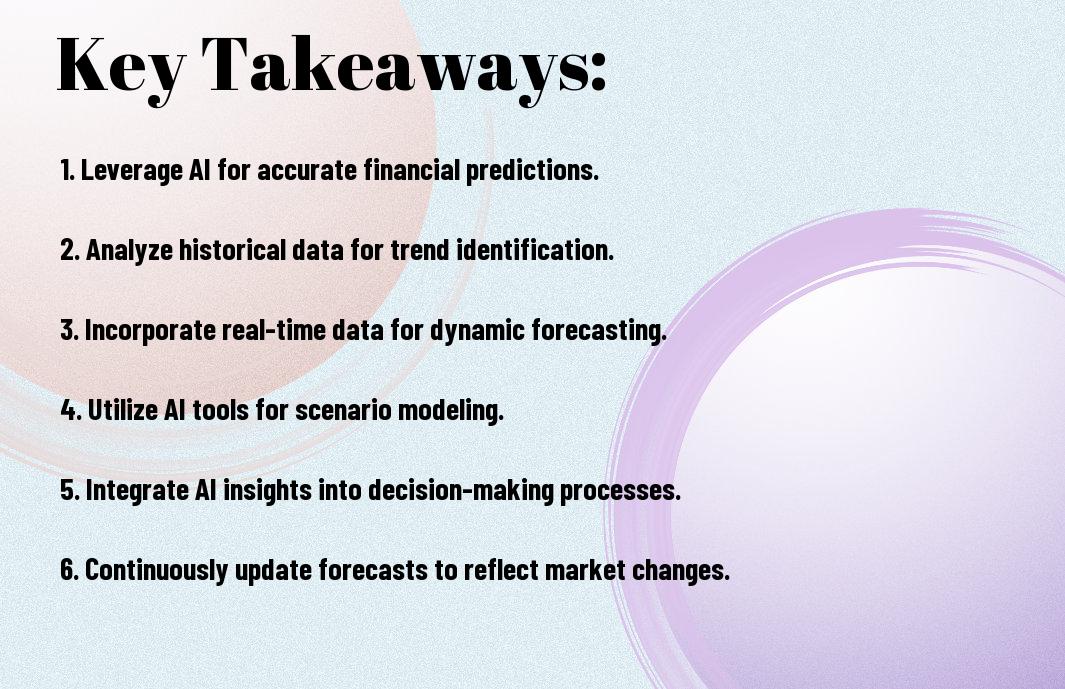As you navigate the complex world of business, you need to stay ahead of the curve when it comes to financial forecasting. With the rise of Artificial Intelligence (AI), you have access to powerful tools that can help you make informed decisions about your company’s financial future. You can leverage AI-driven insights to optimize your financial planning, identify potential risks, and capitalize on new opportunities, ultimately driving your business forward in a competitive market.

Key Takeaways:
- Financial forecasting in the age of AI requires entrepreneurs to leverage machine learning algorithms and data analytics to make informed decisions and stay ahead of the competition.
- AI-powered forecasting tools can help entrepreneurs identify trends, predict revenue, and detect potential risks, enabling them to adjust their business strategies accordingly.
- To effectively utilize AI in financial forecasting, entrepreneurs must ensure the quality and accuracy of their data, as well as develop a deep understanding of the underlying algorithms and models used in AI forecasting tools.
- AI-driven financial forecasting can also facilitate scenario planning and what-if analysis, allowing entrepreneurs to simulate different business scenarios and make more informed decisions about investments, funding, and resource allocation.
- By embracing AI in financial forecasting, entrepreneurs can enhance their financial planning, reduce uncertainty, and drive business growth, ultimately gaining a competitive edge in their respective markets.

The Evolution of Financial Forecasting
A decade ago, financial forecasting was a time-consuming and labor-intensive process, but with the advent of technology, it has become more efficient and accurate, allowing you to make informed decisions about your business.
Traditional Methods and Their Limitations
Emerging from manual calculations and spreadsheets, traditional financial forecasting methods had significant limitations, restricting your ability to analyze large datasets and make predictions, which often led to inaccurate forecasts and poor decision-making.
The AI Revolution in Financial Prediction
Between the lines of code and complex algorithms, AI has transformed the financial forecasting landscape, enabling you to analyze vast amounts of data, identify patterns, and make predictions with unprecedented accuracy, giving you a competitive edge in the market.
And as you examine deeper into the world of AI-powered financial forecasting, you will discover that machine learning algorithms can be trained on your company’s historical data, allowing you to generate forecasts that are tailored to your specific business needs, and enabling you to respond quickly to changes in the market, making your business more agile and responsive to opportunities and challenges.
Core AI Technologies Reshaping Forecasting
Assuming you’re familiar with the basics of AI, you’ll want to explore the core technologies driving forecasting innovation, including machine learning and natural language processing, which are revolutionizing your ability to analyze data and make predictions.
Machine Learning Algorithms for Pattern Recognition
Around the concept of pattern recognition, you’ll find machine learning algorithms that enable your systems to learn from data, identify trends, and make accurate forecasts, allowing you to refine your business strategies.
Natural Language Processing for Market Sentiment
Naturally, your ability to analyze market sentiment is enhanced by natural language processing, which enables you to gauge market attitudes and opinions, providing valuable insights to inform your forecasting decisions.
Sentiment analysis, in particular, allows you to explore deeper into market sentiment, analyzing text data from various sources, such as social media and news articles, to determine the emotional tone and opinions of your target audience, giving you a more nuanced understanding of market trends and enabling you to make more informed forecasting decisions.
Implementation Strategies for Entrepreneurs
Not all entrepreneurs have the resources to invest in complex AI systems, but you can still benefit from financial forecasting with simpler tools.
Starting Small: Entry-Level AI Tools
For your business, finding the right entry-level AI tools is key to getting started with financial forecasting, and you can begin by exploring cloud-based solutions that offer affordable pricing plans.
Building an AI-Ready Financial Framework
At the heart of effective financial forecasting is a well-structured financial framework, and you should focus on organizing your financial data in a way that allows for seamless integration with AI tools.
Also, as you build your AI-ready financial framework, you will need to consider factors such as data quality, security, and scalability, ensuring that your system can grow with your business and adapt to changing market conditions, allowing you to make informed decisions with your financial forecasts.
Data Quality and Management
Now that you’re leveraging AI for financial forecasting, it’s imperative to focus on data quality and management. Your ability to make accurate predictions relies heavily on the accuracy and relevance of your data.
Critical Data Sources for Effective Forecasting
For your financial forecasting to be effective, you need to identify the most relevant data sources. You should consider internal data, such as sales and revenue, as well as external data, like market trends and economic indicators.
Ensuring Data Integrity and Compliance
One of the most significant challenges you’ll face is ensuring the integrity and compliance of your data. You must implement robust data governance policies to protect your data from errors, inconsistencies, and unauthorized access.
In addition, to maintain data integrity, you should regularly audit your data, use data validation techniques, and ensure that your data management systems are compliant with relevant regulations, such as GDPR or HIPAA, to avoid any potential risks or penalties that could impact your business.
Risk Assessment and Mitigation
Once again, you will need to evaluate the potential risks associated with your financial forecasting strategies, considering the integration of AI technologies and their potential impact on your business decisions.
Identifying Blind Spots in AI Predictions
On the other hand, you should be aware of the limitations of AI predictions, identifying potential blind spots that may affect the accuracy of your financial forecasts, and taking steps to address these gaps in your decision-making process.
Creating Balanced Human-AI Decision Systems
Mitigating the risks associated with AI-driven financial forecasting requires you to create a balanced system, where human judgment and oversight complement the insights generated by AI algorithms, ensuring that your decisions are informed and effective.
Hence, as you develop your balanced human-AI decision system, you will need to consider the strengths and weaknesses of both human and AI components, designing a framework that leverages the accuracy and speed of AI, while also incorporating the nuance and expertise that you and your team bring to the decision-making process, ultimately enabling you to make more informed and effective financial decisions.
Competitive Advantages Through AI Forecasting
After implementing AI forecasting, you can gain a significant edge over your competitors, enabling your business to make informed decisions and drive growth.
Speed and Agility in Market Response
Advantageously, you can respond quickly to changes in the market, allowing your business to stay ahead of the curve and capitalize on new opportunities.
Precision Targeting of Growth Opportunities
Akin to having a crystal ball, you can identify areas of high growth potential, enabling your business to focus its efforts and resources on the most promising areas.
Also, by leveraging AI forecasting, you can analyze vast amounts of data to identify subtle patterns and trends, allowing you to pinpoint specific growth opportunities that may have gone unnoticed through traditional forecasting methods, and make targeted investments to drive your business forward.
To wrap up
Considering all points, you now have a solid foundation in financial forecasting with AI. You can leverage AI tools to analyze your business data, identify trends, and make informed decisions. By implementing these strategies, you will enhance your financial forecasting capabilities, driving your business towards success. Your ability to adapt to AI-driven financial forecasting will set you apart as a forward-thinking entrepreneur, enabling you to stay ahead of the competition and achieve your goals.
FAQ
Q: What is financial forecasting in the age of AI, and how does it impact entrepreneurs?
A: Financial forecasting in the age of AI involves using artificial intelligence and machine learning algorithms to analyze historical data, market trends, and other factors to predict future financial outcomes. This technology enables entrepreneurs to make more informed decisions, identify potential risks, and capitalize on new opportunities. By leveraging AI-powered financial forecasting tools, entrepreneurs can streamline their financial planning, reduce uncertainty, and drive business growth.
Q: How can entrepreneurs effectively integrate AI-driven financial forecasting into their business strategies?
A: To effectively integrate AI-driven financial forecasting into their business strategies, entrepreneurs should start by identifying their specific financial forecasting needs and goals. They should then select AI-powered tools that align with these objectives and provide accurate, reliable data. Additionally, entrepreneurs should invest time in understanding the capabilities and limitations of their chosen AI tools, ensuring they are used in conjunction with human judgment and expertise. Regularly reviewing and updating financial forecasts is also crucial to adapt to changing market conditions and business circumstances.
Q: What are the key benefits of using AI for financial forecasting, and how can entrepreneurs measure the success of their AI-driven financial forecasting strategies?
A: The key benefits of using AI for financial forecasting include enhanced accuracy, improved speed, and increased efficiency in financial planning and decision-making. AI can analyze vast amounts of data quickly and identify patterns that may elude human analysts, leading to more precise predictions. To measure the success of their AI-driven financial forecasting strategies, entrepreneurs should track key performance indicators (KPIs) such as forecast accuracy, return on investment (ROI), and the impact on business growth and profitability. Regular assessment and adjustment of AI models based on new data and outcomes are also vital to ensure the ongoing effectiveness of financial forecasting efforts.



